Abstract
The influence of staphylococcal cell wall products (teichoic acid, peptidoglycan) and enterotoxin B on peripheral blood lymphocytes (PBL) from patients with atopic dermatitis (AD) was investigated. The parameters studied were spontaneous and interleukin-inducible immunoglobulin (IgA, IgE, IgG) synthesis and CD23 expression. PBL from non-atopic donors served as controls. Teichoic acid and peptidoglycan induced an enhanced synthesis of IgA and IgG in normal donors. However, IgA and IgG synthesis in PBL from patients with AD was significantly suppressed by teichoic acid and enterotoxin B. The incubation of PBL from normal donors with enterotoxin B and interleukin-4 (IL-4) or IL-5 led to a significant suppression of IgA and IgG synthesis. Co-stimulation of PBL with teichoic acid or peptidoglycan and IL-4 led to a pronounced increase in IgE synthesis and CD23 expression in patients with AD. Our data indicate that cell wall products and toxins of staphylococci modulate the cytokine-dependent humoral immunity in patients with AD and may be responsible for allergic skin reactions in AD.
Full text
PDF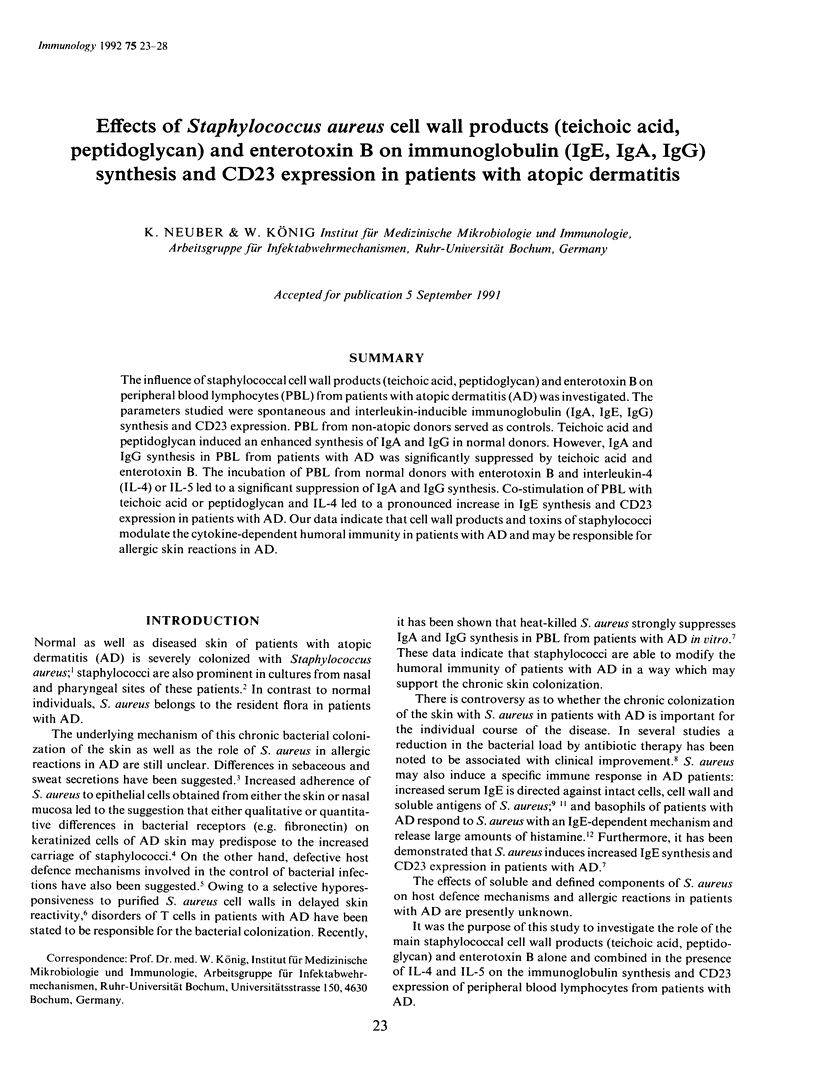
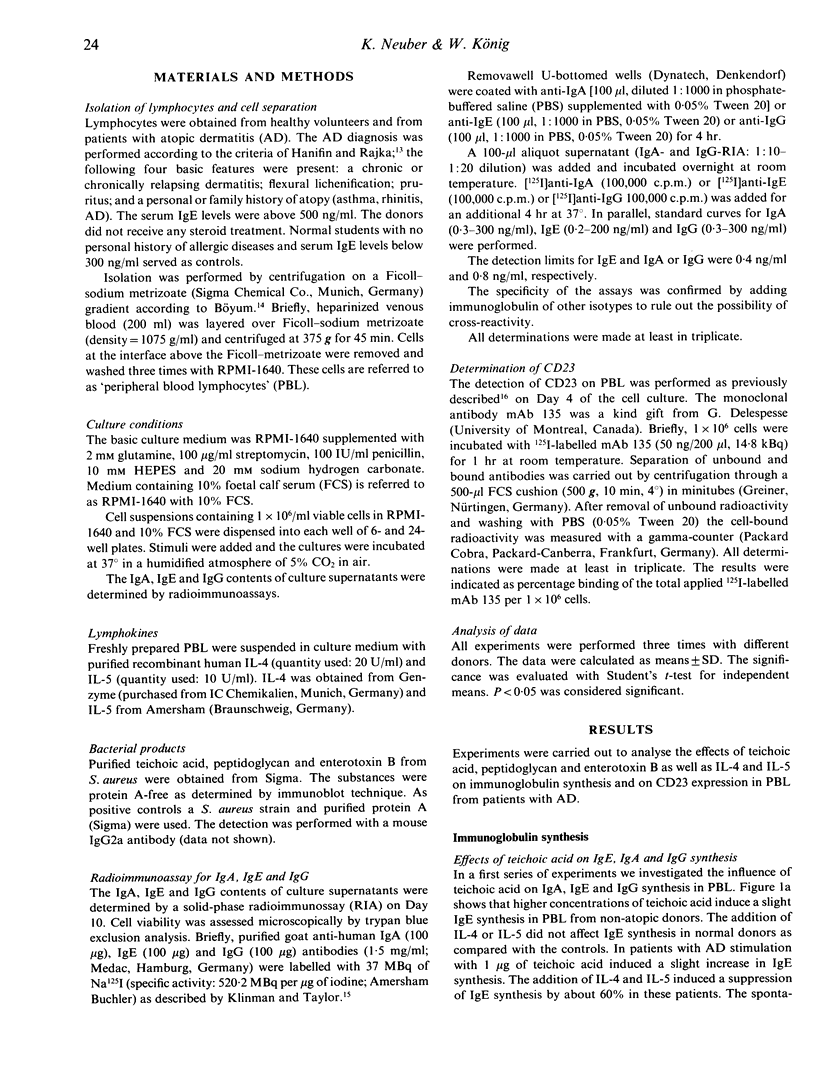
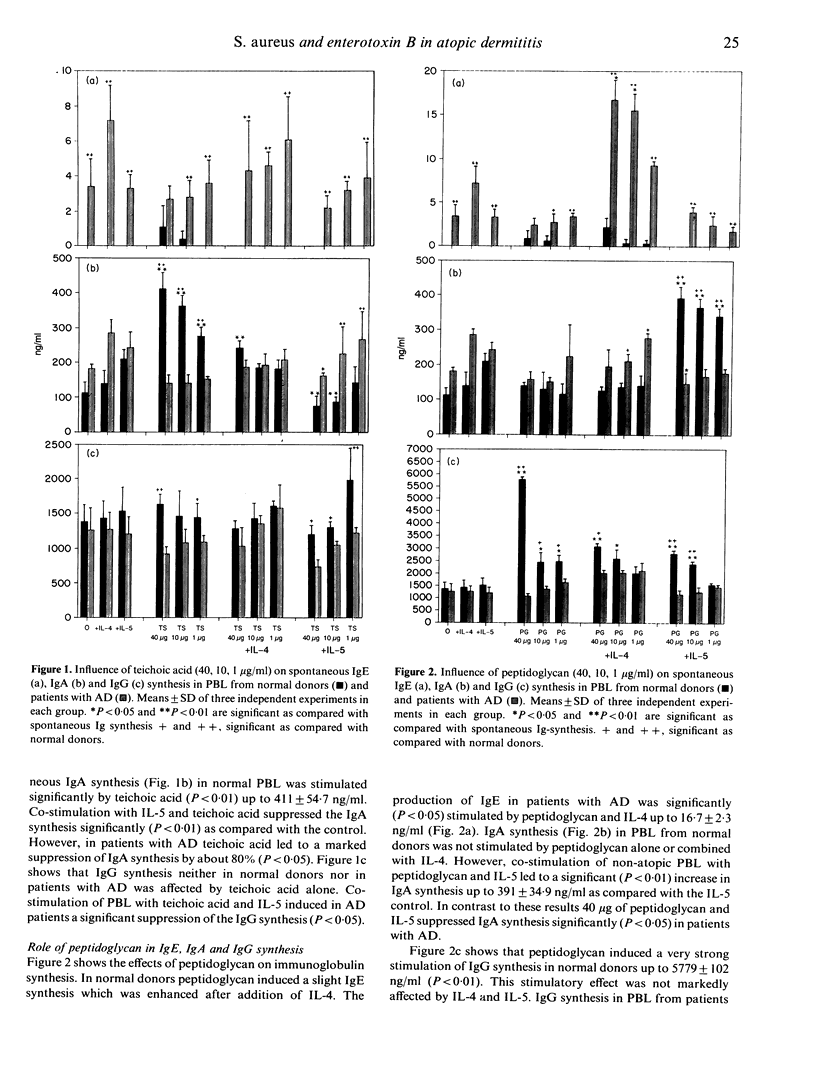
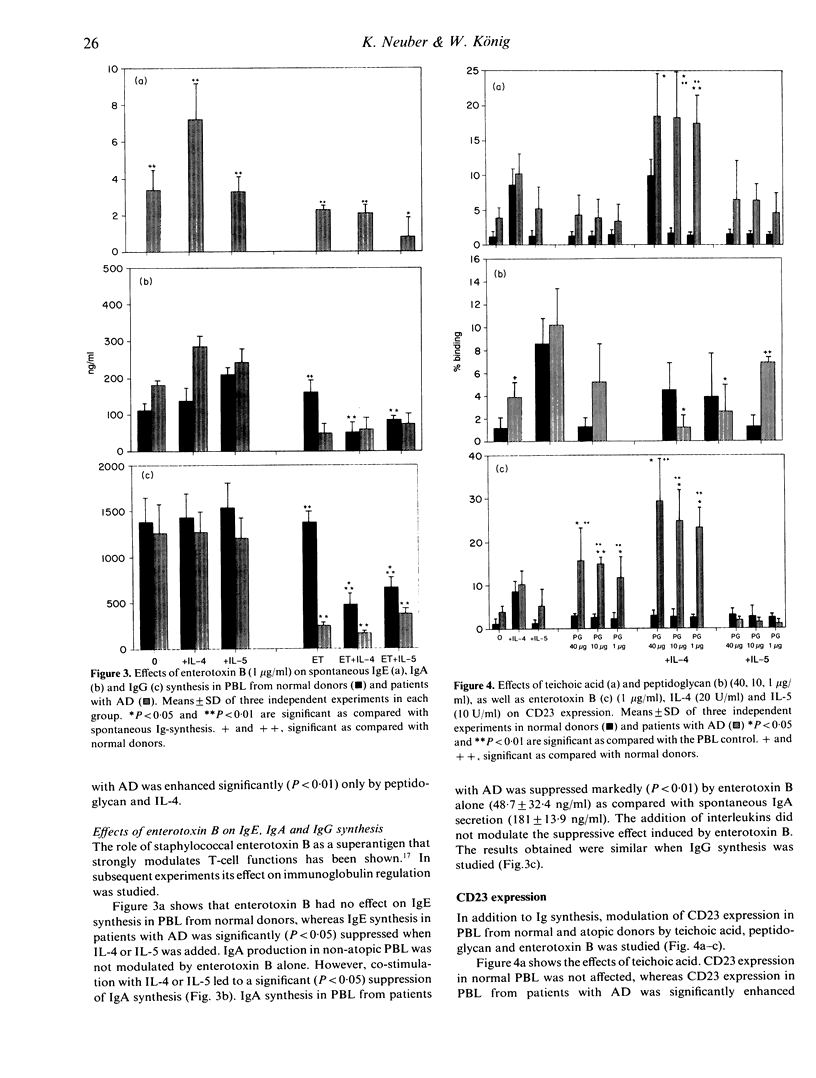
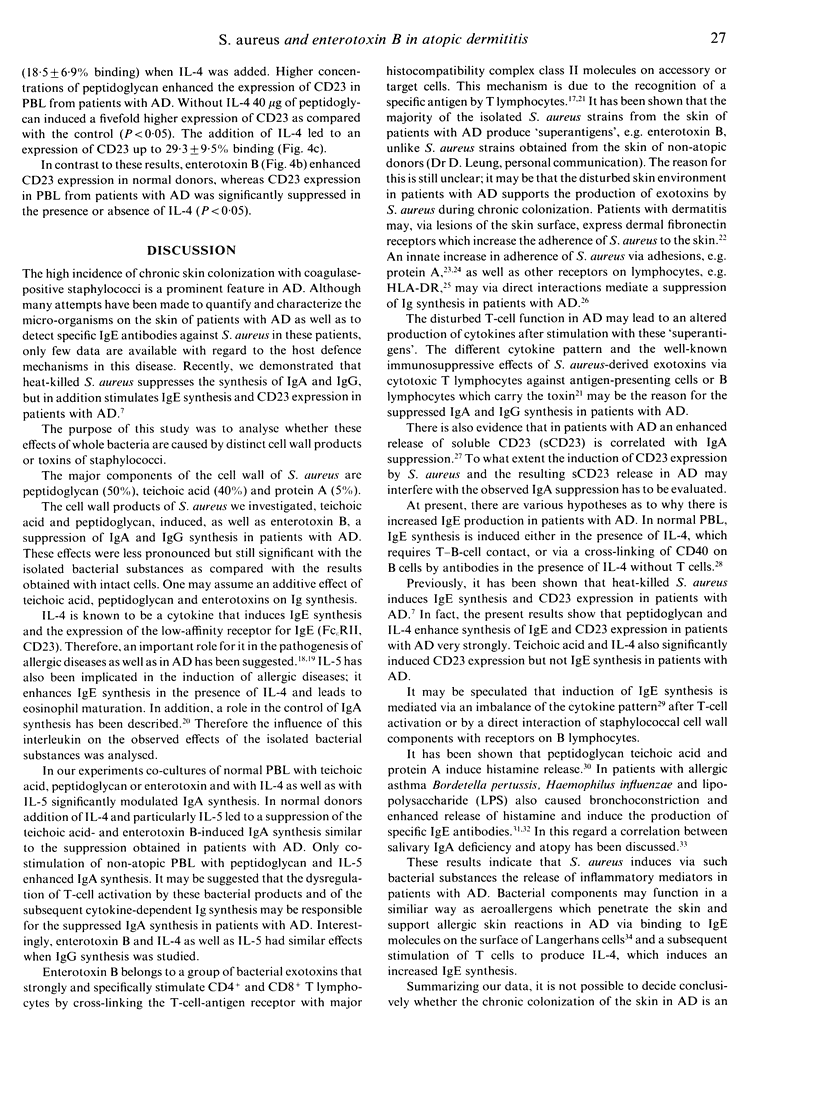
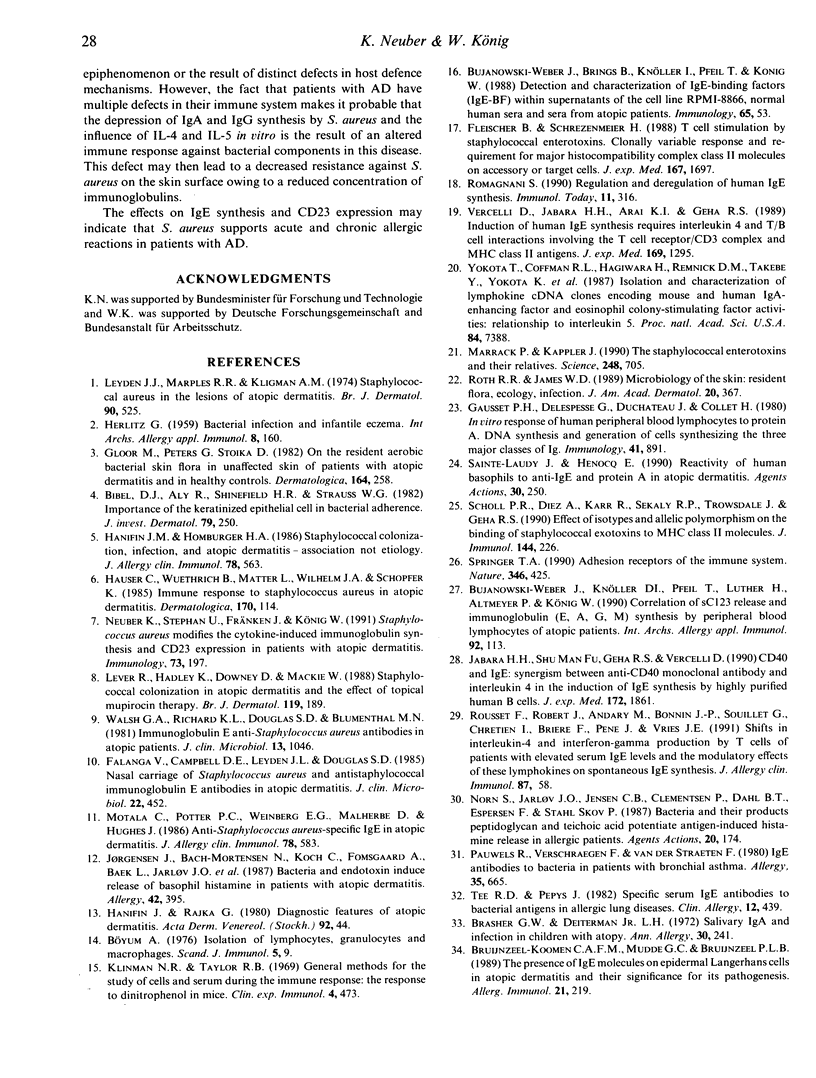
Selected References
These references are in PubMed. This may not be the complete list of references from this article.
- Bibel D. J., Aly R., Shinefield H. R., Maibach H. I., Strauss W. G. Importance of the keratinized epithelial cell in bacterial adherence. J Invest Dermatol. 1982 Oct;79(4):250–253. doi: 10.1111/1523-1747.ep12500072. [DOI] [PubMed] [Google Scholar]
- Brasher G. W., Deiterman L. H., Jr Salivary IgA and infection in children with atopy. Ann Allergy. 1972 May;30(5):241–244. [PubMed] [Google Scholar]
- Bruijnzeel-Koomen C. A., Mudde G. C., Bruijnzeel P. L. The presence of IgE molecules on epidermal Langerhans cells in atopic dermatitis and their significance for its pathogenesis. Allerg Immunol (Paris) 1989 Jun;21(6):219–223. [PubMed] [Google Scholar]
- Bujanowski-Weber J., Knöller I., Brings B., Pfeil T., König W. Detection and characterization of IgE-binding factors (IgE-BF) within supernatants of the cell line RPMI-8866, normal human sera and sera from atopic patients. Immunology. 1988 Sep;65(1):53–58. [PMC free article] [PubMed] [Google Scholar]
- Bujanowski-Weber J., Knöller I., Pfeil T., Luther H., Altmeyer P., König W. Correlation of sCD23 release and immunoglobulin (E, A, G, M) synthesis by peripheral blood lymphocytes of atopic patients. Int Arch Allergy Appl Immunol. 1990;92(2):113–118. doi: 10.1159/000235200. [DOI] [PubMed] [Google Scholar]
- Bøyum A. Isolation of lymphocytes, granulocytes and macrophages. Scand J Immunol. 1976 Jun;Suppl 5:9–15. [PubMed] [Google Scholar]
- Falanga V., Campbell D. E., Leyden J. J., Douglas S. D. Nasal carriage of Staphylococcus aureus and antistaphylococcal immunoglobulin E antibodies in atopic dermatitis. J Clin Microbiol. 1985 Sep;22(3):452–454. doi: 10.1128/jcm.22.3.452-454.1985. [DOI] [PMC free article] [PubMed] [Google Scholar]
- Fleischer B., Schrezenmeier H. T cell stimulation by staphylococcal enterotoxins. Clonally variable response and requirement for major histocompatibility complex class II molecules on accessory or target cells. J Exp Med. 1988 May 1;167(5):1697–1707. doi: 10.1084/jem.167.5.1697. [DOI] [PMC free article] [PubMed] [Google Scholar]
- Gausset P., Delespesse G., Duchateau J., Collet H. In vitro response of human peripheral blood lymphocytes of protein A. DNA synthesis and generation of cells synthesizing the three major classes of Ig. Immunology. 1980 Dec;41(4):891–897. [PMC free article] [PubMed] [Google Scholar]
- Gloor M., Peters G., Stoika D. On the resident aerobic bacterial skin flora in unaffected skin of patients with atopic dermatitis and in healthy controls. Dermatologica. 1982 Apr;164(4):258–265. doi: 10.1159/000250099. [DOI] [PubMed] [Google Scholar]
- HERLITZ G. Bacterial infection and infantile eczema. Int Arch Allergy Appl Immunol. 1956;8(3):160–164. doi: 10.1159/000228278. [DOI] [PubMed] [Google Scholar]
- Hanifin J. M., Homburger H. A. Staphylococcal colonization, infection, and atopic dermatitis--association not etiology. J Allergy Clin Immunol. 1986 Oct;78(4 Pt 1):563–566. doi: 10.1016/0091-6749(86)90071-0. [DOI] [PubMed] [Google Scholar]
- Hauser C., Wuethrich B., Matter L., Wilhelm J. A., Schopfer K. Immune response to Staphylococcus aureus in atopic dermatitis. Dermatologica. 1985;170(3):114–120. doi: 10.1159/000249514. [DOI] [PubMed] [Google Scholar]
- Jabara H. H., Fu S. M., Geha R. S., Vercelli D. CD40 and IgE: synergism between anti-CD40 monoclonal antibody and interleukin 4 in the induction of IgE synthesis by highly purified human B cells. J Exp Med. 1990 Dec 1;172(6):1861–1864. doi: 10.1084/jem.172.6.1861. [DOI] [PMC free article] [PubMed] [Google Scholar]
- Jørgensen J., Bach-Mortensen N., Koch C., Fomsgaard A., Baek L., Jarløv J. O., Espersen F., Jensen C. B., Skov P. S., Norn S. Bacteria and endotoxin induce release of basophil histamine in patients with atopic dermatitis. In vitro experiments with S. aureus, teichoic acid, E. coli and E. coli LPS. Allergy. 1987 Jul;42(5):395–397. doi: 10.1111/j.1398-9995.1987.tb02227.x. [DOI] [PubMed] [Google Scholar]
- Klinman N. R., Taylor R. B. General methods for the study of cells and serum during the immune response: the response to dinitrophenyl in mice. Clin Exp Immunol. 1969 Apr;4(4):473–487. [PMC free article] [PubMed] [Google Scholar]
- Lever R., Hadley K., Downey D., Mackie R. Staphylococcal colonization in atopic dermatitis and the effect of topical mupirocin therapy. Br J Dermatol. 1988 Aug;119(2):189–198. doi: 10.1111/j.1365-2133.1988.tb03201.x. [DOI] [PubMed] [Google Scholar]
- Leyden J. J., Marples R. R., Kligman A. M. Staphylococcus aureus in the lesions of atopic dermatitis. Br J Dermatol. 1974 May;90(5):525–530. doi: 10.1111/j.1365-2133.1974.tb06447.x. [DOI] [PubMed] [Google Scholar]
- Marrack P., Kappler J. The staphylococcal enterotoxins and their relatives. Science. 1990 May 11;248(4956):705–711. doi: 10.1126/science.2185544. [DOI] [PubMed] [Google Scholar]
- Motala C., Potter P. C., Weinberg E. G., Malherbe D., Hughes J. Anti-Staphylococcus aureus-specific IgE in atopic dermatitis. J Allergy Clin Immunol. 1986 Oct;78(4 Pt 1):583–589. doi: 10.1016/0091-6749(86)90075-8. [DOI] [PubMed] [Google Scholar]
- Neuber K., Stephan U., Fränken J., König W. Staphylococcus aureus modifies the cytokine-induced immunoglobulin synthesis and CD23 expression in patients with atopic dermatitis. Immunology. 1991 Jun;73(2):197–204. [PMC free article] [PubMed] [Google Scholar]
- Norn S., Jarløv J. O., Jensen C. B., Clementsen P., Dahl B. T., Espersen F., Stahl Skov P. Bacteria and their products peptidoglycan and teichoic acid potentiate antigen-induced histamine release in allergic patients. Agents Actions. 1987 Apr;20(3-4):174–177. doi: 10.1007/BF02074661. [DOI] [PubMed] [Google Scholar]
- Pauwels R., Verschraegen G., van der Straeten M. IgE antibodies to bacteria in patients with bronchial asthma. Allergy. 1980 Dec;35(8):665–669. doi: 10.1111/j.1398-9995.1980.tb02019.x. [DOI] [PubMed] [Google Scholar]
- Romagnani S. Regulation and deregulation of human IgE synthesis. Immunol Today. 1990 Sep;11(9):316–321. doi: 10.1016/s0167-5699(10)80004-0. [DOI] [PubMed] [Google Scholar]
- Roth R. R., James W. D. Microbiology of the skin: resident flora, ecology, infection. J Am Acad Dermatol. 1989 Mar;20(3):367–390. doi: 10.1016/s0190-9622(89)70048-7. [DOI] [PubMed] [Google Scholar]
- Sainte-Laudy J., Henocq E. Reactivity of human basophils to anti-IgE and protein A in atopic dermatitis. Agents Actions. 1990 Apr;30(1-2):250–253. doi: 10.1007/BF01969052. [DOI] [PubMed] [Google Scholar]
- Springer T. A. Adhesion receptors of the immune system. Nature. 1990 Aug 2;346(6283):425–434. doi: 10.1038/346425a0. [DOI] [PubMed] [Google Scholar]
- Tee R. D., Pepys J. Specific serum IgE antibodies to bacterial antigens in allergic lung disease. Clin Allergy. 1982 Sep;12(5):439–450. doi: 10.1111/j.1365-2222.1982.tb01642.x. [DOI] [PubMed] [Google Scholar]
- Vercelli D., Jabara H. H., Arai K., Geha R. S. Induction of human IgE synthesis requires interleukin 4 and T/B cell interactions involving the T cell receptor/CD3 complex and MHC class II antigens. J Exp Med. 1989 Apr 1;169(4):1295–1307. doi: 10.1084/jem.169.4.1295. [DOI] [PMC free article] [PubMed] [Google Scholar]
- Walsh G. A., Richards K. L., Douglas S. D., Blumenthal M. N. Immunoglobulin E anti-Staphylococcus aureus antibodies in atopic patients. J Clin Microbiol. 1981 Jun;13(6):1046–1048. doi: 10.1128/jcm.13.6.1046-1048.1981. [DOI] [PMC free article] [PubMed] [Google Scholar]
- Yokota T., Coffman R. L., Hagiwara H., Rennick D. M., Takebe Y., Yokota K., Gemmell L., Shrader B., Yang G., Meyerson P. Isolation and characterization of lymphokine cDNA clones encoding mouse and human IgA-enhancing factor and eosinophil colony-stimulating factor activities: relationship to interleukin 5. Proc Natl Acad Sci U S A. 1987 Nov;84(21):7388–7392. doi: 10.1073/pnas.84.21.7388. [DOI] [PMC free article] [PubMed] [Google Scholar]


